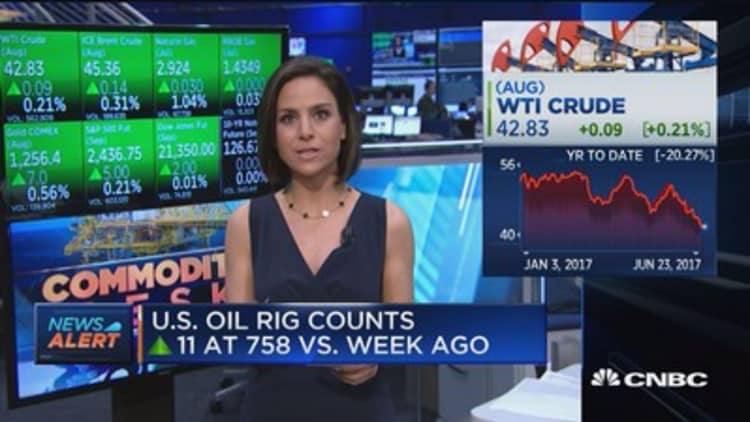Oil prices crept higher on Monday in quiet trade that featured bargain hunting after prices slid to seven-month lows last week, but gains were limited by rising crude supply in the United States and other countries.
Brent crude futures were up 31 cents at $45.85 per barrel by 2:36 p.m. ET (1836 GMT), having hit a trough of $44.35 on June 21, its lowest since November.
U.S. West Texas Intermediate crude futures ended Monday's session 37 cents higher at $43.38 per barrel. They struck $42.05, their lowest level since Aug. 11, also on June 21.
"I think it's mostly bottom fishing at this point," said John Kilduff, partner with energy hedge fund Again Capital in New York, who noted there was some "book squaring" with the end of the quarter approaching.
"After how much we've fallen prices are attractive here as a result, so it's not surprising that we're getting some buying, just on a valuation perspective."

In the week to June 20, investors in U.S. crude futures and options increased their short positions, or bets against rising prices.
The rise in supplies threatens to scupper efforts by the Organization of the Petroleum Exporting Countries and its partners to force a drawdown in global oil inventories via production cuts.
OPEC states and 11 other exporters agreed in May to extend cuts of 1.8 million barrels per day until March 2018, in the hope that it would force global supply and demand to align.
However, U.S. shale oil output is up around 10 percent since last year to around 9.35 million barrels per day. Other non-OPEC producers like Brazil, as well as OPEC members Nigeria and Libya, who are exempt from the cuts, have also hiked output.
Iran, which was given a small increase so it could recover market share lost while under Western sanctions, said its production has surpassed 3.8 million barrels per day and is expected output to reach 4 million barrels per day by March.
"U.S. production could jump to 10, maybe 10.5 million barrels a day by the end of the year, and when you add Libya, Nigeria and North Sea production that will negate the Saudi-led cuts," said Gene McGillian, manager of market research at Tradition Energy in Stamford, Connecticut.
U.S. drillers have added rigs for 23 straight weeks, energy service company Baker Hughes said on Friday.

"The perception is that were going to have slower exploration activity, but the amount of drilling that we've been doing is going to guarantee production growth for at least another four or five months," said James Williams, president of energy consultant WTRG Economics in London, Arkansas. "So you've still got the downward pressure there."
Traders and analysts said there was little fundamental news to justify much of a bounce in oil prices.
"I'm seeing little to convince me that this is anything other than a dead cat bounce," OANDA senior market analyst Craig Erlam said.
"A break above $44.50 in WTI and $47 in Brent may suggest were seeing a broader correction, something that at this stage is looking unlikely," he said.
Analysts at Bank of America-Merrill Lynch said that while supply was a problem, demand had not grown quickly enough to mop up any excess output.
"Looking into the second half of 2017, we now doubt that demand growth will accelerate sufficiently," they wrote.
— CNBC's Tom DiChristopher contributed to this story.

